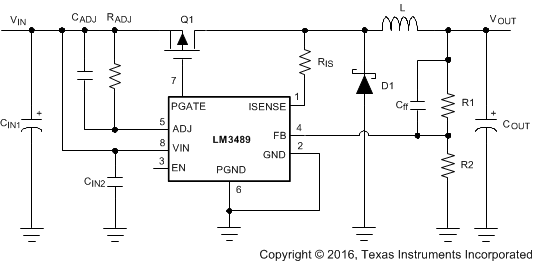-
LM3489x Hysteretic PFET Buck Controller With Enable Pin
- 1 Features
- 2 Applications
- 3 Description
- 4 Revision History
- 5 Pin Configuration and Functions
- 6 Specifications
- 7 Detailed Description
- 8 Application and Implementation
- 9 Power Supply Recommendations
- 10Layout
- 11Device and Documentation Support
- 12Mechanical, Packaging, and Orderable Information
- IMPORTANT NOTICE
LM3489x Hysteretic PFET Buck Controller With Enable Pin
1 Features
- Qualified for Automotive Parts
- AEC-Q100 Qualified With the Following Results:
- Device Temperature Grade 1: –40°C to 125°C Ambient Operating Temperature Range
- Device HBM ESD Classification Level 2
- Device CDM ESD Classification Level C5
- Easy-to-Use Control Methodology
- No Control Loop Compensation Required
- Wide 4.5-V to 35-V Input Range
- 1.239 V to VIN Adjustable Output Range
- High Efficiency: 93%
- ±1.3% (±2% Over Temperature) Internal Reference
- 100% Duty Cycle Operation
- Maximum Operation Frequency > 1 MHz
- Current Limit Protection
- Dedicated Enable Pin (on if Unconnected)
- Shutdown Mode Draws Only 7-µA Supply Current
- 8-Pin VSSOP Package
2 Applications
- Set-Top Boxes
- DSL or Cable Modems
- PC/IA
- Auto PCs
- TFT Monitors
- Battery-Powered Portable Applications
- Distributed Power Systems
- Always-On Power
- High-Power LED Drivers
- Automotive
3 Description
The LM3489 device is a high-efficiency PFET switching regulator controller that can be used to quickly and easily develop a small, cost-effective, switching buck regulator for a wide range of applications. The hysteretic control architecture provides for simple design without any control loop stability concerns using a wide variety of external components. The PFET architecture also allows for low component count as well as ultra-low dropout, 100% duty cycle operation. Another benefit is high efficiency operation at light loads without an increase in output ripple. A dedicated enable pin provides a shutdown mode drawing only 7 µA. Leaving the enable pin unconnected defaults to on.
Current limit protection can be implemented by measuring the voltage across the PFET’s RDS(ON), thus eliminating the need for a sense resistor. A sense resistor may be used to improve current limit accuracy if desired. The cycle-by-cycle current limit can be adjusted with a single resistor, ensuring safe operation over a range of output currents.
Device Information(1)
| PART NUMBER | PACKAGE | BODY SIZE (NOM) |
|---|---|---|
| LM3489 LM3489-Q1 |
VSSOP (8) | 3.00 mm × 3.00 mm |
- For all available packages, see the orderable addendum at the end of the data sheet.
Typical Application Circuit

4 Revision History
Changes from B Revision (February 2013) to C Revision
- Added ESD Ratings table, Feature Description section, Device Functional Modes, Application and Implementation section, Power Supply Recommendations section, Layout section, Device and Documentation Support section, and Mechanical, Packaging, and Orderable Information sectionGo
- Added AEC-Q100 Qualification bullets to FeaturesGo
- Deleted Lead temperature (Vapor phase and Infrared maximums)Go
- Added Thermal Information tableGo
Changes from A Revision (February 2013) to B Revision
- Changed layout of National Semiconductor Data Sheet to TI formatGo